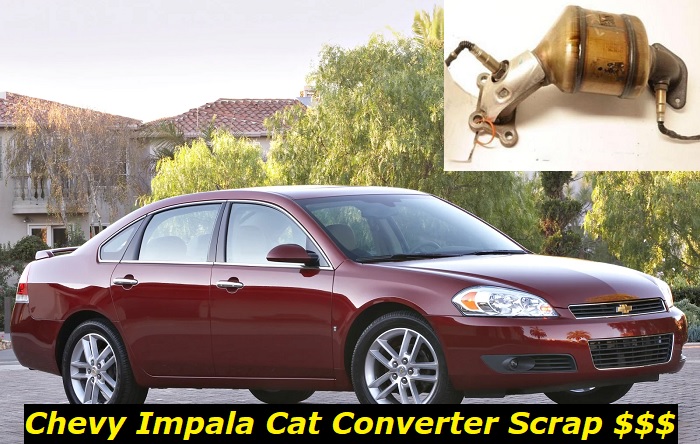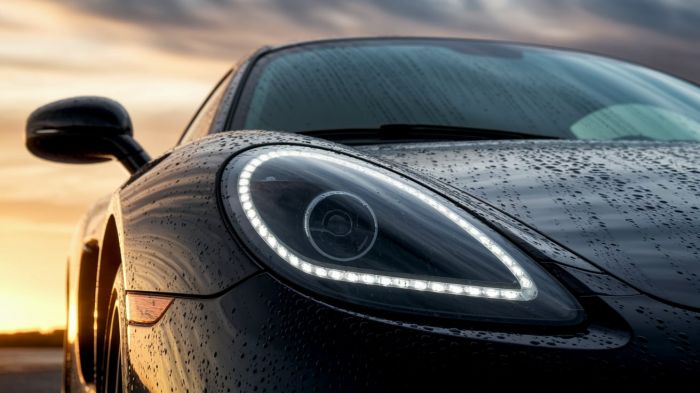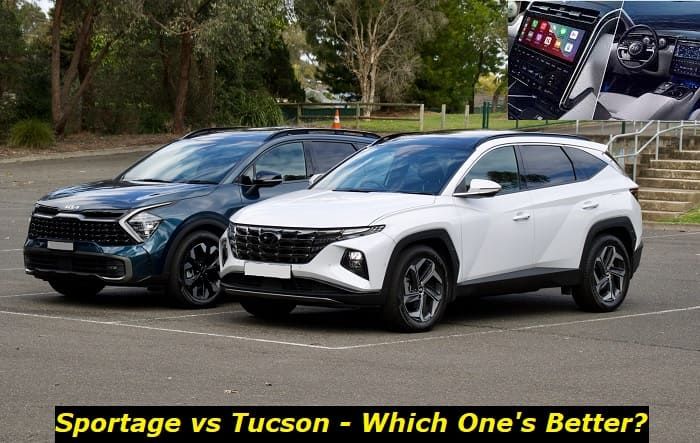Your Chevy Impala has a catalytic converter when it leaves the factory. Unfortunately, the converter may develop issues throughout the car's natural lifespan. This problem often comes with the OBDII code P0420. A brilliant idea, catalytic converters dramatically cut the number of toxic pollutants released into the environment.
Catalysts are valued as a source of valuable resources because of their practical purpose and the materials used in their manufacture.
Removing the catalytic converter and selling it as a used component or scrap is an excellent idea. You should do this if you have a Chevy Impala that is unsuitable for sale and you have no choice but to sell it in parts.

The price of junk catalytic converters varies widely, from about $150 for an aftermarket catalytic converter to $1100 for an OEM part. So, we have you covered whether you want to sell your Impala catalytic converter or buy a replacement part to repair your car.
In this article, we will discuss why scrap catalytic converters are so expensive and what price range you can expect depending on the make and model of your vehicle. Several aspects go into the value of an Impala catalytic converter.
What You Need to Know About Catalytic Converters
Before the development of catalytic converters, all exhaust gasses from internal combustion engines were released into the environment.
Most cars at that time used carburetor injection, an inferior method. Although unleaded gasoline has been widely available since 1975, leaded gasoline was still used until 1996 due to inadequate government controls.
All of these factors combined to create unhealthy traffic congestion in cities and a significant global environmental problem.
While the switch to direct-injection systems allowed for more accurate fuel delivery, higher performance, and lower pollutant production, these benefits alone were not enough to meet environmental regulations.
How Does Your Impala's Catalytic Converter Work?
Since there are no moving elements within the housing, the catalytic converter's working concept is relatively straightforward. As a result, heat and exhaust gases are the only things required for chemical change.
Two honeycomb meshes are present within the catalytic converter, one covered in platinum and rhodium and the other in platinum and palladium.
The exhaust emissions' chemical makeup consists of various carbon-hydrogens, nitrogen oxides, and carbon oxides (CO and CO2).
The heat and the initial honeycomb mesh in the catalytic converter will cause the chemical bonds to break when these components enter it, resulting in the creation of N2, CO, O2, H2O, CxHx, and CO2. In other words, your Impala's catalytic converter reduces the engine's "bad" emissions.
The oxidation process, which produces molecules like N2, CO2, H2O, and CO2 that are far less dangerous than they were in their initial states, is carried out by the second honeycomb mesh.
A 3-way catalytic converter is crucial for reducing emissions since it has an efficiency rate of over 90%.
Why Are Catalytic Converters So Expensive?
A catalytic converter's manufacturing process isn't challenging. Therefore, that doesn't explain why it costs so much. Instead, rhodium, platinum, and palladium give it worth. Rhodium costs $495 per gram or $15,400 per ounce. Palladium costs $2,049 per ounce or $65 per gram. Platinum costs $977 per ounce or $31 per gram.
Catalytic converters often find three to seven grams of platinum, two to seven grams of palladium, and one to two grams of rhodium. After calculating, this amounts to at least $700 in precious metals, but there is a catch.
These metals have a "thin" presence over your Impala's converter's honeycomb mesh. The catalytic converter must undergo several smelts to remove them. The OEM versions of a car converter are still quite valuable.
- Metal and Ceramic Meshes
Although ceramic meshes are excellent at catching exhaust gases, they are more difficult to recycle than metal ones. So, it's likely that you won't be able to recycle your catalytic converter if it contains ceramic. On the other hand, the metal mesh should be simple to recycle if you have some.
Your Impala's catalytic converter's inside mesh has two purposes: it slows down the air that travels through it and collects debris. As a result, before they can use them in new cars, makers must completely purify and smelt the metal meshes in the converter.
- Metal Defense
We now reach the shielding that envelops and shields the inside of your Impala's catalytic converter.
Usually, this metal is not expensive. Instead, it features a thin sheet of stainless steel metal. However, because sheet metal takes about 80% of the catalytic converters' bulk, you may still sell it for a fair price.
Where Is the Catalytic Converter on the Impala?
The location of the catalytic converter in your Chevy Impala depends on the model year and the size of your car's engine. But it's not that difficult to find it. The catalytic converter itself is a part of the exhaust system. You'll eventually find it between the intake manifolds and the exhaust if you follow it.
The lambda sensor and heat barrier are often located before the Impala catalytic converters. The catalytic converter should be visible before the muffler. The only part on your Chevy Impala that you can mistake for the catalytic converter is the muffler.
Depending on the model and year of the vehicle, the catalytic converter may be bolted or welded to the car.
How Can I Check the Price of a Catalytic Converter?
There are many methods for determining an Impala's catalytic converter's cost:
- To identify the pricing, search recycling websites
- Take a photo of your Impala's converter using a mobile app to get a quotation
- Look for secondhand catalytic converters for sale on online markets
- Make a phone call or go in person to the scrapyard
- Utilize the serial number to check the pricing
Examining internet tables and catalogs given by the most prominent recycling organizations is the quickest approach to determining the pricing for junk catalytic converters.
These tables provide an estimated price or a price range for a collection of automobiles. Still, they are not entirely accurate and do not include information relevant to any model.
You can obtain direct quotations using a mobile app or if you submit a photo and a completed form on a website. The support staff will provide you with a price as soon as they have determined the worth of your catalytic converter.
Before selling the converter for scrap, it is usually a good idea to search used car parts markets. Used OEM converters are in high demand since they are superior to aftermarket alternatives and much less expensive than brand-new converters.
You may use a serial number to get a quotation. Still, you can also verify the price by calling the scrapyard or going there in person. In the following section, we'll discuss the final technique in greater depth.
How Can You Verify the Serial Number of Your Impala's Catalytic Converter?
It's relatively simple to check your Impala catalytic converter's serial number. You can find this number near or on the edge of the component. Vehicles have different car serial numbers than the Vehicle Identification Number (VIN).
The serial number of a catalytic converter is a valuable piece of information for obtaining the proper pricing quotation right up there with the VIN. The main challenge is removing the serial number of the converter since, for the most part, it corrodes with the housing.
Thankfully, there are a few methods to get the serial number. However, even if the stamp is faded, you must first find it since it is often adjacent to the O2 sensor hole.
- To clean the serial number and highlight the contrast between the housing and the etching, rub it with oil.
- If that is insufficient to reveal the whole number, you may gently scrape the rust and grime off to reveal the numerals with a piece of steel wool. Just take care not to overwork it since you might flush the numbers with the housing if you do.
- Once you have the whole number, you may enter it into conversion databases to get an exact pricing quotation.
Scrap Catalytic Converter Cost for a Chevy Impala
As mentioned, the price of a catalytic converter for your Impala depends on the engine size and model year. However, catalytic converters are often not inexpensive. They are among the things on a car that gets most often stolen. They typically cost more than $100, and a huge one that fits behind a V8 may cost several hundred dollars.
A trip to the exhaust shop will often be necessary since replacing the catalytic converter sometimes necessitates welding. After everything is said and done, Impala from later model years might cost more than $1,000. Additionally, the typical catalytic converter has a scrap value of up to $250.
About the authors
The CarAraC research team is composed of seasoned auto mechanics and automotive industry professionals, including individuals with advanced degrees and certifications in their field. Our team members boast prestigious credentials, reflecting their extensive knowledge and skills. These qualifications include: IMI: Institute of the Motor Industry, ASE-Certified Master Automobile Technicians; Coventry University, Graduate of MA in Automotive Journalism; Politecnico di Torino, Italy, MS Automotive Engineering; Ss. Cyril and Methodius University in Skopje, Mechanical University in Skopje; TOC Automotive College; DHA Suffa University, Department of Mechanical Engineering






Add comment